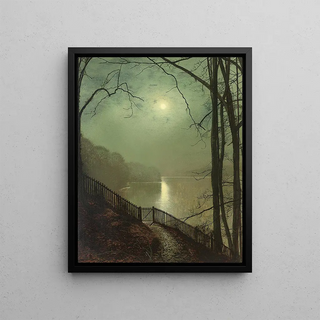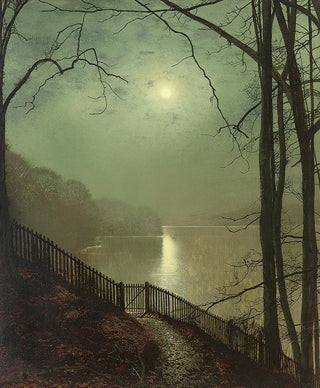Art print | Moonlight over Roundhay Park Lake in Leeds - John Atkinson Grimshaw


View from behind

Frame (optional)
In the fascinating universe of art, some works transcend time and space, captivating the mind and soul of viewers. "Clair de lune sur le lac Roundhay Park Leeds" by John Atkinson Grimshaw is one of these magical creations. Painted at the end of the 19th century, this piece evokes an atmosphere of serenity and mystery, where moonlight dances on the calm waters of the lake. Grimshaw, with his unparalleled talent for capturing nuances of light, manages to create an ambiance that is both nostalgic and dreamlike, inviting the viewer to immerse themselves in a poetic world. This art print allows appreciation of the beauty of this iconic painting, while offering a window into the artist's imagination.
Style and uniqueness of the work
Grimshaw's style is distinguished by its poetic realism, an approach that combines technical precision with emotional sensitivity. In "Clair de lune sur le lac Roundhay Park Leeds," the meticulous details of the trees and reflections on the water are rendered with remarkable delicacy. The color palette, dominated by shades of blue and silver, evokes a peaceful night, while the touches of light add an almost supernatural dimension to the scene. The artist skillfully plays with shadows and lights, creating a striking contrast that draws the eye toward the heart of the composition. This painting is not just a depiction of a landscape; it is an invitation to feel the magic of a summer night, where each element seems to whisper forgotten secrets. Grimshaw's mastery in using light is particularly striking, transforming a simple nocturnal scene into a vibrant and lively art print.
The artist and his influence
John Atkinson Grimshaw, born in 1836, is often regarded as one of the masters of nocturnal landscapes. His career, marked by a constant exploration of light and atmosphere, profoundly influenced the artistic movement of the late 19th century. Grimshaw drew inspiration from the Impressionists while maintaining a unique approach that is his own. His works, often imbued with melancholy, testify

Matte finish

View from behind

Frame (optional)
In the fascinating universe of art, some works transcend time and space, captivating the mind and soul of viewers. "Clair de lune sur le lac Roundhay Park Leeds" by John Atkinson Grimshaw is one of these magical creations. Painted at the end of the 19th century, this piece evokes an atmosphere of serenity and mystery, where moonlight dances on the calm waters of the lake. Grimshaw, with his unparalleled talent for capturing nuances of light, manages to create an ambiance that is both nostalgic and dreamlike, inviting the viewer to immerse themselves in a poetic world. This art print allows appreciation of the beauty of this iconic painting, while offering a window into the artist's imagination.
Style and uniqueness of the work
Grimshaw's style is distinguished by its poetic realism, an approach that combines technical precision with emotional sensitivity. In "Clair de lune sur le lac Roundhay Park Leeds," the meticulous details of the trees and reflections on the water are rendered with remarkable delicacy. The color palette, dominated by shades of blue and silver, evokes a peaceful night, while the touches of light add an almost supernatural dimension to the scene. The artist skillfully plays with shadows and lights, creating a striking contrast that draws the eye toward the heart of the composition. This painting is not just a depiction of a landscape; it is an invitation to feel the magic of a summer night, where each element seems to whisper forgotten secrets. Grimshaw's mastery in using light is particularly striking, transforming a simple nocturnal scene into a vibrant and lively art print.
The artist and his influence
John Atkinson Grimshaw, born in 1836, is often regarded as one of the masters of nocturnal landscapes. His career, marked by a constant exploration of light and atmosphere, profoundly influenced the artistic movement of the late 19th century. Grimshaw drew inspiration from the Impressionists while maintaining a unique approach that is his own. His works, often imbued with melancholy, testify






